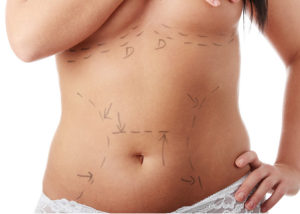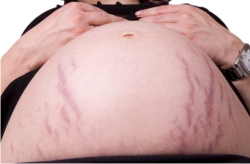Although I wish I could boast about this being MY patient, it is not. She is an excellent writer and I feel she sums up her experience in a lighthearted and sincere manner.
However, I truly believe that anyone considering this type of surgery could benefit from reading this in order to help prepare for their experience!
Karen M. Horton, M.D., M.Sc., F.R.C.S.C.
10 Things I wish I'd known before a Mommy Makeover
 After getting a mommy makeover, I came up with a top 10 list of things I wish I knew ahead of time!
After getting a mommy makeover, I came up with a top 10 list of things I wish I knew ahead of time!1. Guilty as charged.
As most moms do, I tend to put everyone else first. A lot of times that is why women tend to feel like they have lost their identities. It’s hard to spend that much money on yourself, especially for aesthetic reasons. It seems okay to spend it on a car or a trip, but for some reason the thought of spending that money on your body is frowned upon. To some that may seem vain or boastful. For me it was about a self confidence that I had yet to achieve, a love of self that I have longed for my entire life. When I look in the mirror I like what I see now. When I feel good about myself…inside and out…I am a better woman, a better wife, and a better mom. It is absolutely normal to feel guilty about spending money on a mommy makeover and it is okay to finally put yourself first. It is the best money I have ever spent…just ask my family.
2. What to tell the kids.
This was a big one for me. I am a mom of two young girls (5 and 2). I grew up with a horrible body image and the last thing I wanted was to implement that to my daughters. I was concerned about what to tell the oldest, the two-year-old really didn’t understand. I thought about saying, “Well, you and your sister ruined my body while I was pregnant with you both.” But then I thought maybe that was too harsh. (Note the sarcasm). I have tried really hard not to down myself in front of them, calling myself too fat, or commenting on my huge belly. They see me exercise and make healthy choices, but I didn’t want them to know that I didn’t like my body. So I tried to keep it simple. The day before surgery I told my oldest daughter that I was going to have an operation to fix my tummy (I didn’t go into the whole booby thing). She of coursed asked why, I told her because the doctor said so. I was prepared for more questions but she seemed satisfied with that. I was informed by the ladies on this site that the best thing to do with boys, if they are older, is tell them you are having female surgery. They will shut right up and have no more questions. Nothing is more embarrassing than talking female issues with your mom.
3. I’m a big girl now.
Most mommy makeovers include lipo and a tummy tuck. Which probably means you will be lucky enough to wear a skin-tight crotchless compression garment. I, as most women, chose to wear panties over this outfit so I didn’t feel as it all my “stuff” was being squished out. (Think of baboons….ewww, or don’t.) Now, the tricky part here is the first couple of days after surgery. You will spend quite a bit of time on the toilet the first time you try to pee, similar to what it is like after giving birth. After a couple tries, it gets better. However, when you are taking pain medication and muscle relaxers on a regular basis, your mind may be fuzzy a bit. I had the great luck of forgetting I had those panties on and peeing straight through them…twice. Yes, not once, but twice. I was starting to think I might have to revert back to diapers but I graduated and learned how to use the potty like a big girl. Also, you will probably not poop for several days at first, so expect a good 3-5 days worth of poop on your first time. With that being said, consider pulling your garment down for that endeavor. The back to front wiping thing can be tricky in that thing. I’m just saying, not that it happened or anything…..I’m just saying…okay…next subject please.
4. Hello Dolly!
If you decide to get implants please remember that objects may appear larger than they actually are. When I first took a glance at my new girls, I thought “Holy Mary Mother of God, what have I done?!” I looked like Dolly Parton, or for younger ones, Beth from Dog the Bounty Hunter. This is NOT your final look. Please don’t freak out. The swelling takes a while to go down and for the implants to “drop” into place. After about a week your PS will probably give you the go ahead to start massaging them. Massaging the implants will help them soften up and find their final resting place. Your significant other with love this, and surprisingly, so will you. I was shocked to find how much I actually liked touching my own breasts. It sounds perverted, I know, but if you are used to your “ladies” hanging out down by your belly, then you will see how nice it is to hold them, let go, and be fascinated that they no longer fall down so low anymore. I can now understand why men are always holding onto their own “boys”. They are proud of them. I have caught myself with one hand on the remote and the other on one of my breasts. So relax, and let the boobs fall where they may.
5. Phantom of the itch.
I knew going into the tummy tuck part of the mommy makeover that my belly would be numb. It is a freaky and strange feeling. It is almost like you are rubbing on someone else’s tummy. I had heard before about people who have had an arm or leg amputated and still felt the feeling of it being there, the phantom limb syndrome. I was not prepared for that with my belly. Every now and then, I will get an itch, go to scratch it, and realize it is where my belly is numb. Scratching a numb belly doesn’t relieve the itch. Simple right? Well I have a masters degree and it took several times scratching before I got that one.
6. Sit. Stay. Good girl.
Once again, most mommy makeovers include a tummy tuck. This is a huge procedure and as most of you have surely read, it is a good idea to take off as much time as possible from your job. I was fortunate enough to take 2 weeks off from my PAID position. I capitalize paid, because as all moms know, the mom position is considered a “non for profit” position. Rarely do we moms put in a request for vacation from that position, so therefore we tend to work every day of the year, even if we are taking a vacation from our “paid jobs”. As most moms, I am an expert at multitasking. It was killing me to sit there and not do anything. The first 3 days or so you have no choice, your body will not allow it. I will admit that I probably did more than I should have. Looking back, I wish I would have taken more advantage of the quiet time and rested and relaxed. I was convinced that if I didn’t do it, it wouldn’t get done, and it wouldn’t get done right. I was wrong. Trust your loved ones. My husband was amazing. He became Mr. Mom and was pretty darn good at it. I have never given him enough credit in that department. Granted, it may have not been done the way I do it, but he stepped up and took charge. And if you don’t have someone doing those household chores….so what. Just take this time for yourself and give your body a chance to heal.
7. All aboard...the Bi-Polar Express.
This is a BIG one. Having your body cut upon, stitched up, and hung up to dry is traumatic. Throw a few pain meds into the mix and you will turn into an emotional tornado. I was known to go from ecstatic to tears in 6.9 seconds flat. Top that!! Be aware that this will be an issue, and emotions will be crazy. Explain this to your loved ones and the people caring for you so they don’t call the men in white coats with the strait jackets. When I felt teary, I would cry. It’s ok, you have a permit to go crazy, take advantage of it. When I was feeling really down and out, I typically would go to bed and nap it off. Use this site. Realself.com is full of women who are going through the same thing. Use them to lean on and talk to. The ladies I have met on here have been A HUGE support to me and I couldn’t have gotten through this without them. Well, I would have, but I would have probably been divorced and sitting in a mental institution. Thanks Ladies!!!
8. Let's get physical.
Most people who are looking into plastic surgery are doing so because exercise has not been effective on certain areas of the body. There are only so many chest flies one can do before you realize they won’t make your boobies stand up and say hello. However, there are some who think this is the alternative to diet and exercise. If that is you….you are wrong. I truly believe my fitness level aided in my recovery time. And I know that I will have to work twice as hard to keep my new body looking tip top. The more active and healthy you are before surgery, the better your recovery will be. You will heal faster, feel better sooner, and be back to the gym before you know it. As you heal, stay away from processed and salty foods, soda, and fried foods. You will swell like the Stay Puff Marshmallow Man and be so uncomfortable. When your doctor says its okay, get back into exercising and let your body lead the way. It will tell you what is too much and when to quit.
9. Don't be naive: do the research.
When I decide to do something I go full speed, head first. In this case, you need to know what you are getting into. When I began this journey, I had no idea that there was a difference between a Board Certified Plastic Surgeon and a Board Certified Cosmetic Surgeon. Now, I will not step into the argument of who is more qualified; just know who you are dealing with. Ask around; find people who have used him/her. The doctor will give you referrals, but let’s face it; they are not stupid enough to give you someone who is unhappy with their work. If you know anyone who has had plastic surgery get as much info from them as possible. There will always be someone who is unhappy with a certain PS or procedure they have had done. But there is a HUGE difference between a “well, I just didn’t like his/her bedside manner” or “I just didn’t see a huge difference in my lipo” and the “he completely disfigured me”. Be wary of the flashy salesman. Go with your gut and ask LOTS of questions. The good ones will sit with you and take as much time as needed.
10. Avoid the Debbie Downers.
We all know one….the Debbie Downers, the buzz kill. And most of us will have to deal with a few after surgery. It is really hard when you feel that you don’t have the support from your loved ones. The choice to have a mommy makeover is strictly yours and hopefully you are doing this for you and only you. I have had a few family members of mine that I surprisingly haven’t received support from. It is hurtful, especially since they saw me struggle with my weight and self esteem issues for years. A lot of people will see it as a “waste of money”. I started feeling the need to explain my reasoning for having the surgery. I wanted them to know that it was not out of vanity, or selfishness. But remember the old saying “Those convinced against their will, are of the same opinion still.” It really doesn’t matter. As much as I wanted them to hear me out and understand my reasoning, they won’t. If they love you, they will keep their negative comments to themselves and support you no matter what. But you may have those who love you yet still feel the need to give their opinion even when not asked. My response to those people would be a nod and a smile. (Believe me, I know it’s hard) If you want, throw in a “please keep your negative comments to yourself” or a “if you don’t have anything nice to say…”. But my advice is to steer clear of the “screw you” sort of comment. It is just not worth it. As long as you know why you are doing this that is all you need. For me, being able to look in the mirror, smile and for the first time in my life, love what I see…well that is priceless to me. And for those who can’t see past the money or their opinions, they are missing out on watching someone they love transforming into the person they have always dreamed of being.
For more information or to ask questions directly about Mommy Makeover surgery, visit my website!











 We were so lucky to get some of the best information on plastic surgery after twins from a Board-Certified Plastic Surgeon. This informative article covers our interview with
We were so lucky to get some of the best information on plastic surgery after twins from a Board-Certified Plastic Surgeon. This informative article covers our interview with  I am a Board-Certified Plastic Surgeon and Reconstructive Microsurgeon, practicing in the Pacific Heights area of San Francisco. I specialize in both reconstructive surgery and cosmetic surgery for women, and in particular, Moms! Please visit
I am a Board-Certified Plastic Surgeon and Reconstructive Microsurgeon, practicing in the Pacific Heights area of San Francisco. I specialize in both reconstructive surgery and cosmetic surgery for women, and in particular, Moms! Please visit  Many women find their abdomens have
Many women find their abdomens have  Loss of breast volume after having children is corrected by placing a breast implant behind the breast tissue to fill out what has been lost.
Loss of breast volume after having children is corrected by placing a breast implant behind the breast tissue to fill out what has been lost.  A Mom should do her homework when seeking a Plastic Surgeon! You will be trusting your body to this person! Do your 'due diligence'. The surgeon should be Board-Certified and a member of the
A Mom should do her homework when seeking a Plastic Surgeon! You will be trusting your body to this person! Do your 'due diligence'. The surgeon should be Board-Certified and a member of the 




